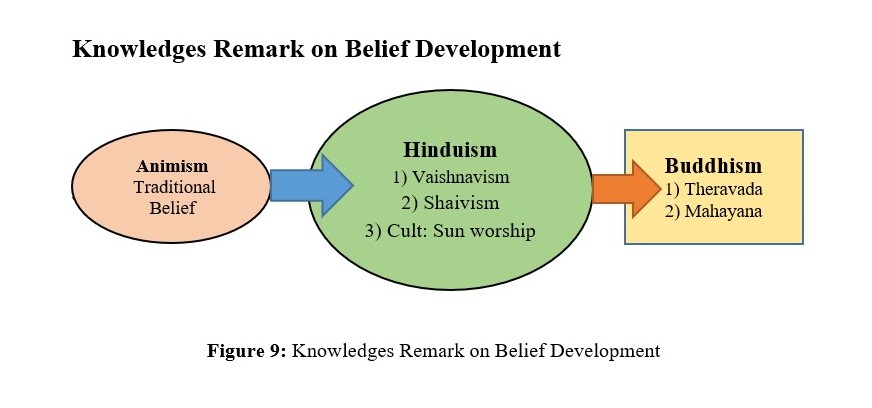Analysis of Beliefs and Religions in the Dvaravati Era in the Ancient City of Sri Thep, Petchaburi Province, Thailand
Main Article Content
Abstract
Archaeological evidence has been discovered to date that informs the development of people living in the former Thailand from prehistoric times to historical times. However, human development from prehistoric times into historical times is not the same in each place, where most of the ancient cities of the Dvaravati period were located on the plains along the banks of important rivers. Those areas are usually in easy contact with other communities; for example, in the Lopburi-Pasak River basin, there was an ancient city called "Sri Thep" and the people of the ancient city of Sri Thep had a traditional belief cult with clear evidence that a spiritually stable culture was the human skeleton buried in earthen hills and many other objects. On the religious side, the ancient city of Sri Thep used to be the center of both Theravada and Mahayana Buddhism. Based on the evidence, large Buddhist scriptures (Dhamma Chakra) inscribed in Balinese and Sanskrit and Amitabha Buddha statues were discovered. The statue respects both Buddha statues and Dhamma Chakra pillars, and a replica stupa, which is the motto of Theravada Buddhism, and Bodhisattva, which are idols in Mahayana traditions in both Hinduism, where stone sculptures of Vishnu and Krishna have been found. From the information studied, it can be concluded that “the ancient city of Sri Thep” has a cult, belief, and religion that has evolved into the main respect of the community in the area up to the present.
Article Details
References
Fine Arts Department. (2011). Sri Thep, the city at the center of prosperity of
the Pa Sak River Basin. Bangkok: Rungsilp Company. Printing (1997) Co., Ltd.
Fine Arts Department. (2007). Sri Thep Historical Park Fine Arts Office 4,
Lopburi. Sri Thep Historical Park. Nakhon Pathom: Rungsilp Printing (1997) Company Limited.
Fine Arts Department. Ministry of Culture (2007), “Sri Thep City
Inscription,” in Sri Thep Historical Park. Bangkok: Limited Partnership Future Press.
Faculty members of Buddhapanyasri Dvaravati Sangha College. (2019).
Reviving the Dvaravati spirit. Nakhon Pathom: SalaPrint.
Jirathi Charoenrat. (13 February 2022). Dvaravati Nakhon Pathom Rajabhat
University. Accessible from the center Learn Dvaravati Studies: http://tvaravati.npru.ac.th/PDF/0011.pdf.
Thida Saraya. (2002). Dvaravati, early Thai history. Bangkok: Dan Suttha
Printing.
Thida Saraya. (1989). (Sri) Dvaravati: Early History of Siam. Bangkok:
Printing House. Imprint.
Teerawat Saenkham. (2012). Relationships between ancient communities in
the Dvaravati period: Pa Sak River Basin and Loei River Basin. Phetchaburi Journal of Arts and Culture, 7.
Bandit Liuchaichan et al. (2010). Report on research results on
Establishment of Buddhism from Lanka. Continent in the territory of Thailand during the Dvaravati culture period. Bangkok: Saphan Publishing House. Ltd.
Banchuen Manop. (2021). Dvaravati: dimensions of belief and religion.
Sirindhorn Journal Periscope, 254-255.
Paladisai Sitthithankit et al. (2012). Dvaravati Kingdom. Bangkok: Thai
Children's Study Friends Company. Ltd.
Sakchai Saisingh. (2019). Dvaravati art, the earliest religious culture in Thai
territory. Bangkok: Muang Boran Publishing House on behalf of Viriya Business Company Limited.
Sathaporn Thiangtham. (2011). Sri Thep, the city at the center of prosperity
of the Pa Sak River Basin. Bangkok: Company Rungsilp Printing (1977) Co., Ltd.
Suraphon Damrihkul. (1985). New knowledge about Sri Thep City. Journal of
Arts and Culture, Year 6, Issue 8 (June. 1985). 11.


